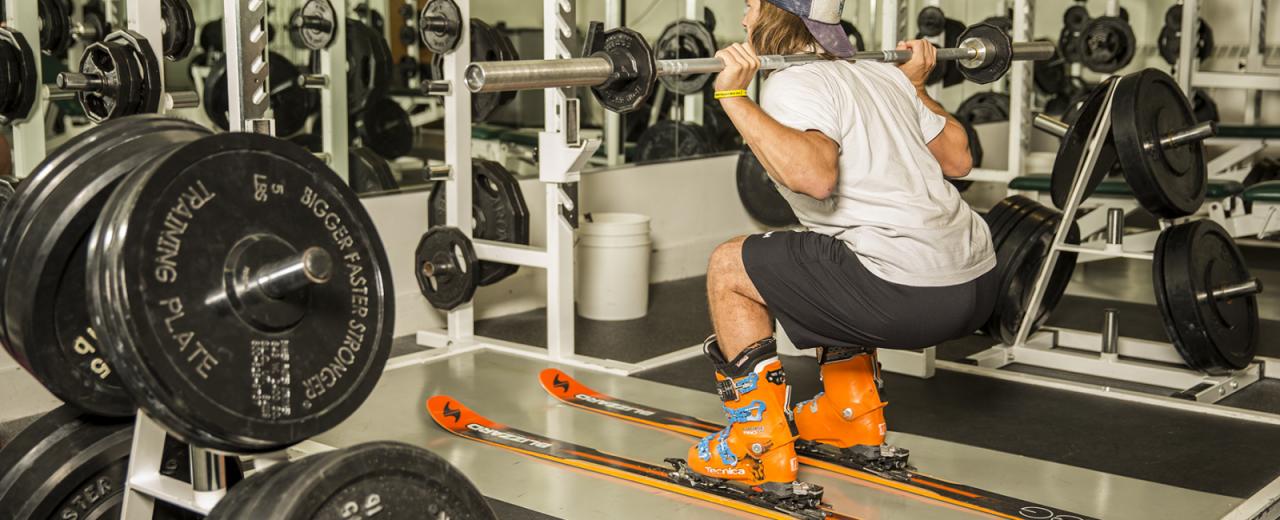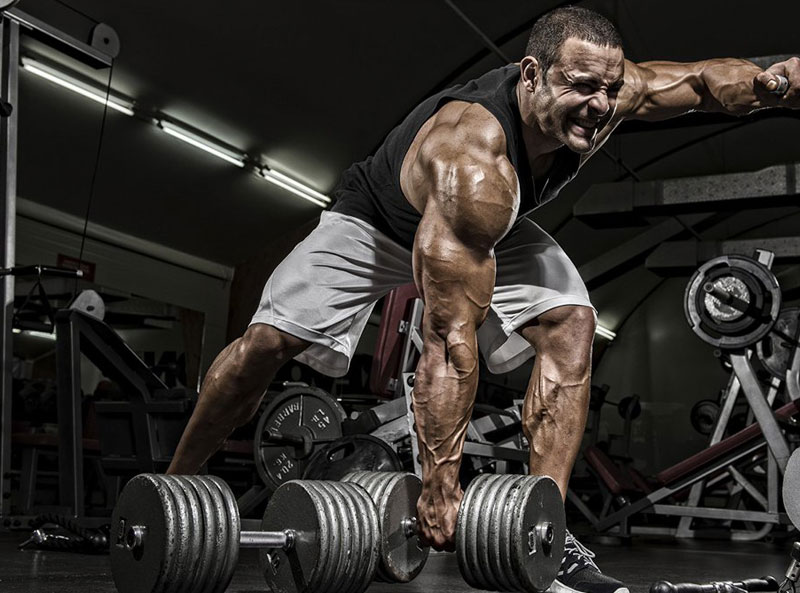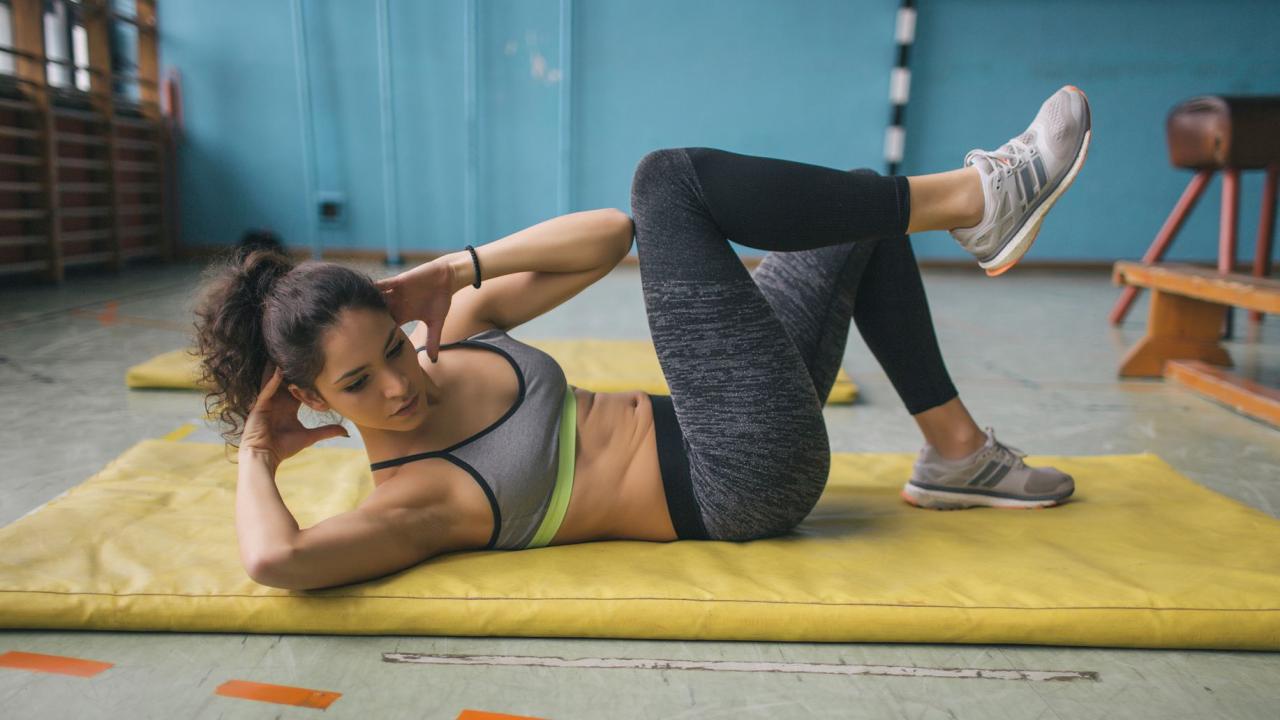If you have to cover the way from the changing room to the parking lot of your local fitness studio in record time because you can only endure a marginal amount of time in the arctic temperatures in your short sports clothes and your protein shake in the air after just a few seconds anabolic block of ice freezes, you know it’s winter now. Time to ski.
The good news: Winter time is training time! While the remaining half of the population is lost in mulled wine, lard cake and gingerbread, you can pursue your need for heavy weights almost undisturbed in the cold season. But what if you have to pause your muscle building training in winter because you are on an annual ski vacation with your family or best friends?

This article equips you with knowledge about skiing and muscle building, with which you can really (or not a bit) get excited at your next après-ski party: Can I build muscles through skiing? Which muscles are particularly important in skiing and how much are they used? How can I optimally prepare for skiing through muscle building training? Let’s get started.
Skiing and muscle building – preparation is everything
So that your ski trip doesn’t end after just a few runs on the “ski autobahn” at the local piste doctor and you have to hide your tender feet in colorful plaster for the rest of the ski holiday or you should only top the list of the daily piste runs from below while and before skiing consider a few things that apply to just about every extreme sport.
At this point I would like to point out that this article is primarily concerned with (in relation to skiing) injury-preventive and performance-oriented training for your muscle building training in the gym and not alpine skiing as an equivalent substitute for an intensive muscle building workout. If your only training goal is “more biceps”, you should not only rethink your role in society, but also refrain from reading this article. Skiing is not a sport that can satisfy your need for massive muscle gains in a very short time.
Even if leisurely cross-country skiing on Sunday afternoons is not necessarily one of the extreme sports, Alpine skiing can definitely be rated as an extreme sport . This is not least due to the relatively high risk of injury, but rather to the complex interaction of many different training parameters, physiological properties and your personal training status . In the following I want to describe the essential factors that have a decisive influence on your performance and susceptibility to injury when skiing. In the second part of this article, we will then go into the respective training options that can optimize the factors mentioned.
- Trunk stability: The stability in the trunk area is – as in so many sports – probably one of the most important factors for an injury-prevention and performance-oriented training. Only when your torso – more precisely the torso muscles – have the necessary stability can your back muscles, front, transverse and lateral abdominal muscles and the entire joint apparatus in the hip area be able to withstand the enormous exercise-induced stress Tuck away from the black piste during an alpine competition or an extraordinarily fast descent and protect your sensitive spine from harmful physical influences. Thus, trained core muscles are the be-all and end-all for every skier!
Are impractical when skiing: Heavy barbells. But the squat is an ingenious tool with which you can specifically simulate the load in the ski crouch.
- Agility: In this case, agility or mobility describes the maximum movement amplitude of your joints, i.e. the largest angle between a muscle stretching and muscle shortening, which is primarily influenced by the elasticity of your ligaments, tendons and muscles. An above-average amplitude of movement has a positive effect on injury prevention and can be improved in the long term through mobility training. With increased mobility you reduce the risk of muscle and ligament tears that are triggered by excessive physical pressure or tensile stress (e.g. as a result of a fall) on your musculoskeletal system.
- Balance: Frequent load changes or the constant shifting of body weight make trained muscle coordination and an above-average sense of balance essential. Only if you can precisely coordinate the constant load changes can you save valuable seconds on the descent and avoid losing speed.
- Energy supply: The subject of energy supply is unfortunately not about the large plates full of Kaiserschmarrn that are served to you by the attractive employees of the woody Alpine huts, but about a central topic that runs through pretty much every one of our articles. A topic that so far only a few athletes have dealt with sufficiently intensively. This is exactly the reason why many inexperienced athletes do not make any training progress. If you don’t know how your own body can meet the energy requirements of your muscles in all imaginable situations, you will never achieve top performance in training. This applies to both skiing and conventional muscle building training.
High-performance skiing: muscle building training par excellence

Of course, we don’t just leave you standing in the sleet with the aforementioned terms torso stability, agility, balance or energy supply. In the second part of this article, we will go into the training-specific possibilities with which you can optimize your skiing performance as part of a classic muscle building training .
Balance training, flexibility training and adequate warm-up training
Even your performance in strength training depends, to an extent that you probably ignore, on how effective your warm-up training is. Because the entire relationship between warm-up, flexibility training and balance training is quite extensive, we only want to briefly explain why warm-up training is so performance-relevant.
Adequate warm-up training is an often underestimated performance parameter that can not only influence your training progress, but is also essential for effective injury prevention during training.
Pretty much all of the biochemical regulatory processes that take place in your body are subject to a certain metabolic inertia. This means that it always takes some time for these processes to work optimally. You have to force them to work effectively. However, this inertia is not the same for all systems, but in some cases very different and thus leads to a frequently occurring divergence in cooperating systems. The warm-up focuses on the equalization of the metabolic activity of all functional systems through a targeted increase in the core body temperature.
According to the reaction rate-temperature rule with every degree increase in the core body temperature, a increase of 13% in the metabolic processes can be determined. The parallel expansion of the capillaries in the working muscle optimizes the oxygen and substrate supply due to improved blood circulation, which not only ensures the classic “red pear” when skiing after you have your ski goggles with the first mulled wine at the subsequent après-ski party finally fogged up.
In addition to the core body temperature, the temperature of the actual tissue also rises, as a result of which the enzyme activity increases significantly and the efficiency of the substrate processing (i.e. the energy supply, more on that later) also increases rapidly. This applies above all to the processes of aerobic and anaerobic energy supply. In the end, the rising tissue temperature improves your overall performance and increases the chances that the alpine talent scout might discover you after all. The contraction speed of the muscles also increases with a temperature increase of 2 ° C by up to 20%, which represents an enormous increase in acceleration and can make up the decisive seconds during load changes when skiing.
At this point, at the latest, it should be clear to you that when skiing you cannot fall back on your everyday training clothing consisting of a tank top and sports pants, but should choose heat-regulating ski clothing such as those from xspo.de so that your core body temperature does not fall in the cold surroundings of the ski slopes drops off too quickly and your level of performance plummets. Doesn’t have to be.
Which warm-up and balance exercises can be sensibly integrated into a preparatory strength training? The following exercises have proven to be suitable assistance exercises for skiing:
- Plyometric training is an ingenious supplement to training, especially for skiers, it can even be described as a separate interval training and fill entire training units
- Lateral jump – 3 × 5 per side
- One-legged hopping, one-legged squat with light weights
- One-legged equilibrium exercises or balancing (with eyes closed)
Static and dynamic strength training

The types of strength are an elementary training basis for targeted muscle building training, because pretty much every training method uses dynamic muscle strength to generate the actual hypertrophy to put for muscle growth. Dynamic strength or muscle work is the most important form of strength for fitness training of any kind and can be broken down into positive (overcoming) and negative (yielding) dynamic muscle work.
With the positive dynamic force one speaks of muscle work, for which a contraction or stretching of the muscle fibers must first be carried out. In our training theory, dynamic strength is now divided into maximum strength, speed strength and strength endurance, on which all other training methods are based and which are taken up again when it comes to providing energy.
In contrast to dynamic force, with static force or muscle work, muscle tension develops without the need for a visible stretching or shortening of the muscles. Both static and dynamic muscle work are used when skiing. If we think back to our load changes, which are often carried out in a crouched position, the static force suddenly seems quite relevant.
The elementary basic exercises, squats and deadlifts, are probably the best addition to effectively increasing dynamic and static strength. Squats in particular and all conceivable types of squats have a demanding movement pattern that comes exceptionally close to the muscular stress of skiing (especially in the crouching position).
Development of stabilizing muscles in the trunk area

Speaking of squats and deadlifts – these basic exercises are the best way to move your core and back muscles in a targeted manner for hypertrophy, so that your spine is functionally supported by strengthening muscle packages and physical loads such as torsion, compression or Can handle stretching better. Without strong back and abdominal muscles, your spine would probably just break through like a dry salt stick in the event of a serious fall. So take your injury prevention training seriously and complete a suitable training plan that implements squats and deadlifts as basic exercises!
Understand and optimize your energy supply
Contrary to many opinions and myths, your performance while skiing is not your (aerobic) endurance, which is optimized through regular and long-lasting cardio training, but rather the anaerobic form of energy supply . In order to be able to briefly explain the relationships, we have to complete a short physiology crash course here.
Depending on the intensity and duration of the exercise, your body is increasingly turning to other energy sources than ATP (adenosine tri-phosphate) so that your muscles can maintain their ability to contract. This is where carbohydrates come into play as a physiological basis for performance.
Your body has developed a multitude of systems of energy supply, which are, however, very dependent on one another. If one system is overloaded, it has far-reaching consequences for the performance of the other systems. The first intense muscle contraction that you e.g. complete during training, is completely supplied by your body’s own ATP. The more intense the training is (the training intensity is generally determined by the amount of load or weights to be overcome), the more important a rapid ATP regeneration becomes for muscle performance.
If the ATP supply is exhausted after around a second , the creatine phosphate can drive the rapid ATP resynthesis for 5-7 seconds. But this process also comes to an end quickly and can be absorbed by the metabolism of stored glycogen for around 45 seconds if the load is continued at moderate intensity. But because you can hopefully stay longer than 45 seconds on the skis, the aerobic energy supply gains in importance with increasing duration of exertion or in the course of your flawless slope descent and ensures increased (Oxidative) burning of carbohydrates and body fat, which has the upper hand for around 30-45 minutes before your metabolism switches almost exclusively to a (not as efficient) aerobic oxidation of fatty acids.
How can I optimize my energy supply for alpine skiing?
- Carbohydrates (glycogen) are the performance basis for your training. So always keep your glycogen stores full. Which brings us back to the topic of Kaiserschmarrn …
- Do about 2-3 training units per week, whose intensity comes very close to interval training, i.e. enables a targeted combination of high-speed and endurance-intensive loads with short breaks.
- Even when skiing, the additional supplementation of creatine phosphate can be useful, so that the time span in which the ATP can be resynthesized through the anaerobic alactic energy supply is maximized.
- Periodize your training and switch between interval training, strength training and specific muscle endurance training (ski squat) and implement basic exercises such as squats and deadlifts in many training units!

